Macroeconomic and Microeconomic Analysis: Fonterra Price Shock Impact
VerifiedAdded on 2022/08/08
|11
|3003
|23
Report
AI Summary
This report examines the impact of price shocks on Fonterra, the largest company in New Zealand's dairy industry, focusing on the period between 2012 and 2018. The analysis is divided into microeconomic and macroeconomic sections. The microeconomic analysis explores the rise in milk prices, the conditions of the dairy industry, farmer responses to price changes, and the causes of oversupply. It highlights the impact of increased demand from China on New Zealand's exports. The macroeconomic analysis investigates the circular flow of income, government expenditure, and the effects of surging dairy exports on price levels and aggregate demand in New Zealand. The report concludes by summarizing the key findings and their implications for the dairy industry and the New Zealand economy. The report also provides graphical representations of the concepts discussed, such as the supply and demand curves, and the circular flow of income.
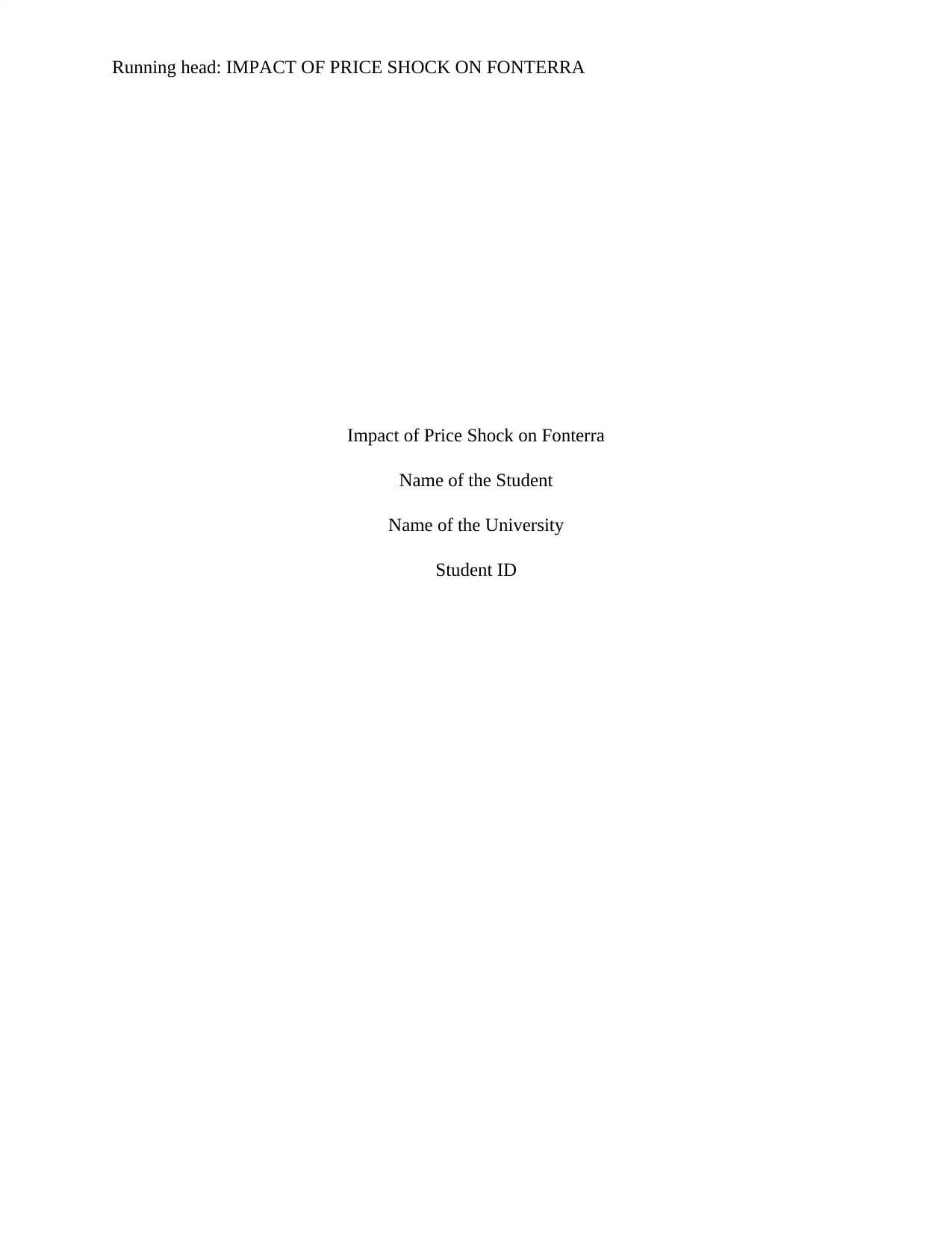
Running head: IMPACT OF PRICE SHOCK ON FONTERRA
Impact of Price Shock on Fonterra
Name of the Student
Name of the University
Student ID
Impact of Price Shock on Fonterra
Name of the Student
Name of the University
Student ID
Paraphrase This Document
Need a fresh take? Get an instant paraphrase of this document with our AI Paraphraser
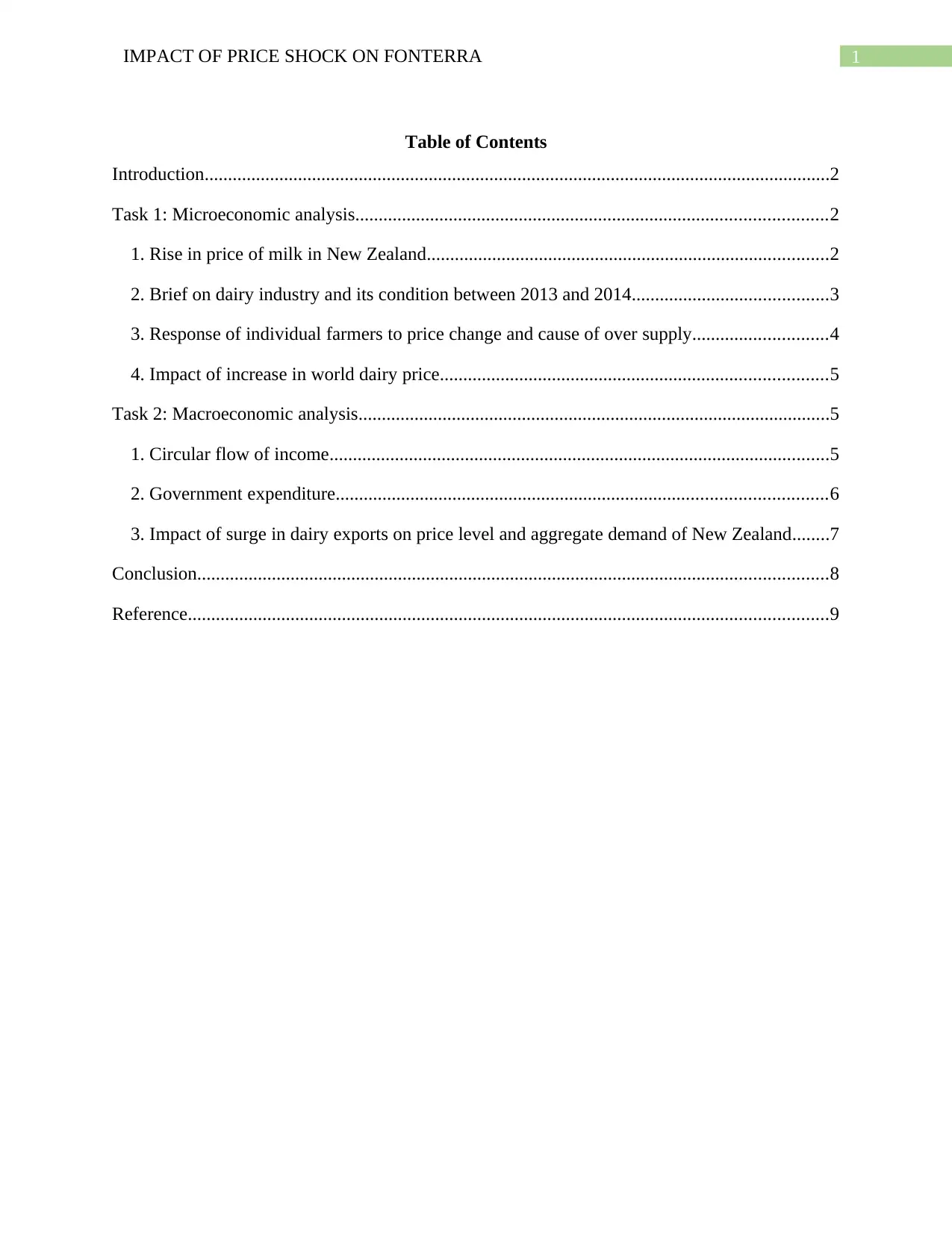
1IMPACT OF PRICE SHOCK ON FONTERRA
Table of Contents
Introduction......................................................................................................................................2
Task 1: Microeconomic analysis.....................................................................................................2
1. Rise in price of milk in New Zealand......................................................................................2
2. Brief on dairy industry and its condition between 2013 and 2014..........................................3
3. Response of individual farmers to price change and cause of over supply.............................4
4. Impact of increase in world dairy price...................................................................................5
Task 2: Macroeconomic analysis.....................................................................................................5
1. Circular flow of income...........................................................................................................5
2. Government expenditure.........................................................................................................6
3. Impact of surge in dairy exports on price level and aggregate demand of New Zealand........7
Conclusion.......................................................................................................................................8
Reference.........................................................................................................................................9
Table of Contents
Introduction......................................................................................................................................2
Task 1: Microeconomic analysis.....................................................................................................2
1. Rise in price of milk in New Zealand......................................................................................2
2. Brief on dairy industry and its condition between 2013 and 2014..........................................3
3. Response of individual farmers to price change and cause of over supply.............................4
4. Impact of increase in world dairy price...................................................................................5
Task 2: Macroeconomic analysis.....................................................................................................5
1. Circular flow of income...........................................................................................................5
2. Government expenditure.........................................................................................................6
3. Impact of surge in dairy exports on price level and aggregate demand of New Zealand........7
Conclusion.......................................................................................................................................8
Reference.........................................................................................................................................9
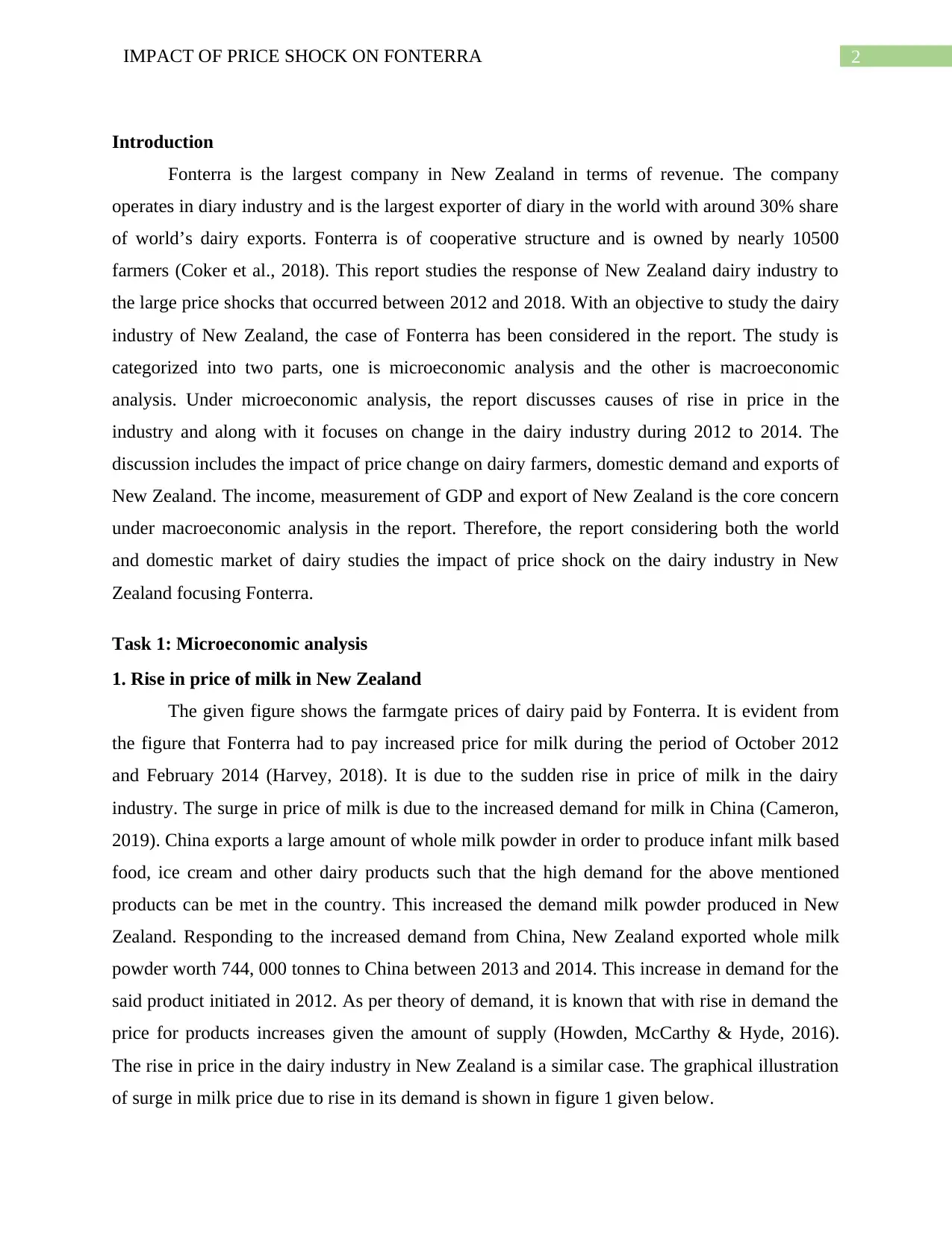
2IMPACT OF PRICE SHOCK ON FONTERRA
Introduction
Fonterra is the largest company in New Zealand in terms of revenue. The company
operates in diary industry and is the largest exporter of diary in the world with around 30% share
of world’s dairy exports. Fonterra is of cooperative structure and is owned by nearly 10500
farmers (Coker et al., 2018). This report studies the response of New Zealand dairy industry to
the large price shocks that occurred between 2012 and 2018. With an objective to study the dairy
industry of New Zealand, the case of Fonterra has been considered in the report. The study is
categorized into two parts, one is microeconomic analysis and the other is macroeconomic
analysis. Under microeconomic analysis, the report discusses causes of rise in price in the
industry and along with it focuses on change in the dairy industry during 2012 to 2014. The
discussion includes the impact of price change on dairy farmers, domestic demand and exports of
New Zealand. The income, measurement of GDP and export of New Zealand is the core concern
under macroeconomic analysis in the report. Therefore, the report considering both the world
and domestic market of dairy studies the impact of price shock on the dairy industry in New
Zealand focusing Fonterra.
Task 1: Microeconomic analysis
1. Rise in price of milk in New Zealand
The given figure shows the farmgate prices of dairy paid by Fonterra. It is evident from
the figure that Fonterra had to pay increased price for milk during the period of October 2012
and February 2014 (Harvey, 2018). It is due to the sudden rise in price of milk in the dairy
industry. The surge in price of milk is due to the increased demand for milk in China (Cameron,
2019). China exports a large amount of whole milk powder in order to produce infant milk based
food, ice cream and other dairy products such that the high demand for the above mentioned
products can be met in the country. This increased the demand milk powder produced in New
Zealand. Responding to the increased demand from China, New Zealand exported whole milk
powder worth 744, 000 tonnes to China between 2013 and 2014. This increase in demand for the
said product initiated in 2012. As per theory of demand, it is known that with rise in demand the
price for products increases given the amount of supply (Howden, McCarthy & Hyde, 2016).
The rise in price in the dairy industry in New Zealand is a similar case. The graphical illustration
of surge in milk price due to rise in its demand is shown in figure 1 given below.
Introduction
Fonterra is the largest company in New Zealand in terms of revenue. The company
operates in diary industry and is the largest exporter of diary in the world with around 30% share
of world’s dairy exports. Fonterra is of cooperative structure and is owned by nearly 10500
farmers (Coker et al., 2018). This report studies the response of New Zealand dairy industry to
the large price shocks that occurred between 2012 and 2018. With an objective to study the dairy
industry of New Zealand, the case of Fonterra has been considered in the report. The study is
categorized into two parts, one is microeconomic analysis and the other is macroeconomic
analysis. Under microeconomic analysis, the report discusses causes of rise in price in the
industry and along with it focuses on change in the dairy industry during 2012 to 2014. The
discussion includes the impact of price change on dairy farmers, domestic demand and exports of
New Zealand. The income, measurement of GDP and export of New Zealand is the core concern
under macroeconomic analysis in the report. Therefore, the report considering both the world
and domestic market of dairy studies the impact of price shock on the dairy industry in New
Zealand focusing Fonterra.
Task 1: Microeconomic analysis
1. Rise in price of milk in New Zealand
The given figure shows the farmgate prices of dairy paid by Fonterra. It is evident from
the figure that Fonterra had to pay increased price for milk during the period of October 2012
and February 2014 (Harvey, 2018). It is due to the sudden rise in price of milk in the dairy
industry. The surge in price of milk is due to the increased demand for milk in China (Cameron,
2019). China exports a large amount of whole milk powder in order to produce infant milk based
food, ice cream and other dairy products such that the high demand for the above mentioned
products can be met in the country. This increased the demand milk powder produced in New
Zealand. Responding to the increased demand from China, New Zealand exported whole milk
powder worth 744, 000 tonnes to China between 2013 and 2014. This increase in demand for the
said product initiated in 2012. As per theory of demand, it is known that with rise in demand the
price for products increases given the amount of supply (Howden, McCarthy & Hyde, 2016).
The rise in price in the dairy industry in New Zealand is a similar case. The graphical illustration
of surge in milk price due to rise in its demand is shown in figure 1 given below.
⊘ This is a preview!⊘
Do you want full access?
Subscribe today to unlock all pages.

Trusted by 1+ million students worldwide

3IMPACT OF PRICE SHOCK ON FONTERRA
Figure 1: Rise in milk price due to increase in its demand
Source: (Created by the Author)
In figure 1, due to rise in milk demand in China the market demand curve shifted outward
in New Zealand. This happens because China imports milk from New Zealand (Zhang et al.,
2017). Therefore, the increased demand given the amount of supply the price of milk in New
Zealand’s dairy industry increased from P to P*.
2. Brief on dairy industry and its condition between 2013 and 2014
New Zealand’s dairy industry is significantly large. It is the largest industry of the
country. There are huge number of farmers involved in dairy farming in the country. However,
for dairy farming there is requirement for specific inputs (Ilyas et al., 2019). The basic inputs that
are required to become a dairy farmer are the food for the cows, land and cows. However, the
becoming a milk processor is a comparatively difficult venture and it requires several inputs and
they are energy inputs such as electricity and heating fuels for the thermal processing plant (Wild
et al., 2019). The major inputs are raw milk, refrigerant, containers and any services required to
maintain the processing plant.
New Zealand’s dairy industry is broadly depended on China. Data show that New
Zealand is exporting milk to China since 2008 after free trade agreement signed between the
concerned two countries (Gooch, Hoskin & Law, 2017). The volume of milk exported to China
Figure 1: Rise in milk price due to increase in its demand
Source: (Created by the Author)
In figure 1, due to rise in milk demand in China the market demand curve shifted outward
in New Zealand. This happens because China imports milk from New Zealand (Zhang et al.,
2017). Therefore, the increased demand given the amount of supply the price of milk in New
Zealand’s dairy industry increased from P to P*.
2. Brief on dairy industry and its condition between 2013 and 2014
New Zealand’s dairy industry is significantly large. It is the largest industry of the
country. There are huge number of farmers involved in dairy farming in the country. However,
for dairy farming there is requirement for specific inputs (Ilyas et al., 2019). The basic inputs that
are required to become a dairy farmer are the food for the cows, land and cows. However, the
becoming a milk processor is a comparatively difficult venture and it requires several inputs and
they are energy inputs such as electricity and heating fuels for the thermal processing plant (Wild
et al., 2019). The major inputs are raw milk, refrigerant, containers and any services required to
maintain the processing plant.
New Zealand’s dairy industry is broadly depended on China. Data show that New
Zealand is exporting milk to China since 2008 after free trade agreement signed between the
concerned two countries (Gooch, Hoskin & Law, 2017). The volume of milk exported to China
Paraphrase This Document
Need a fresh take? Get an instant paraphrase of this document with our AI Paraphraser
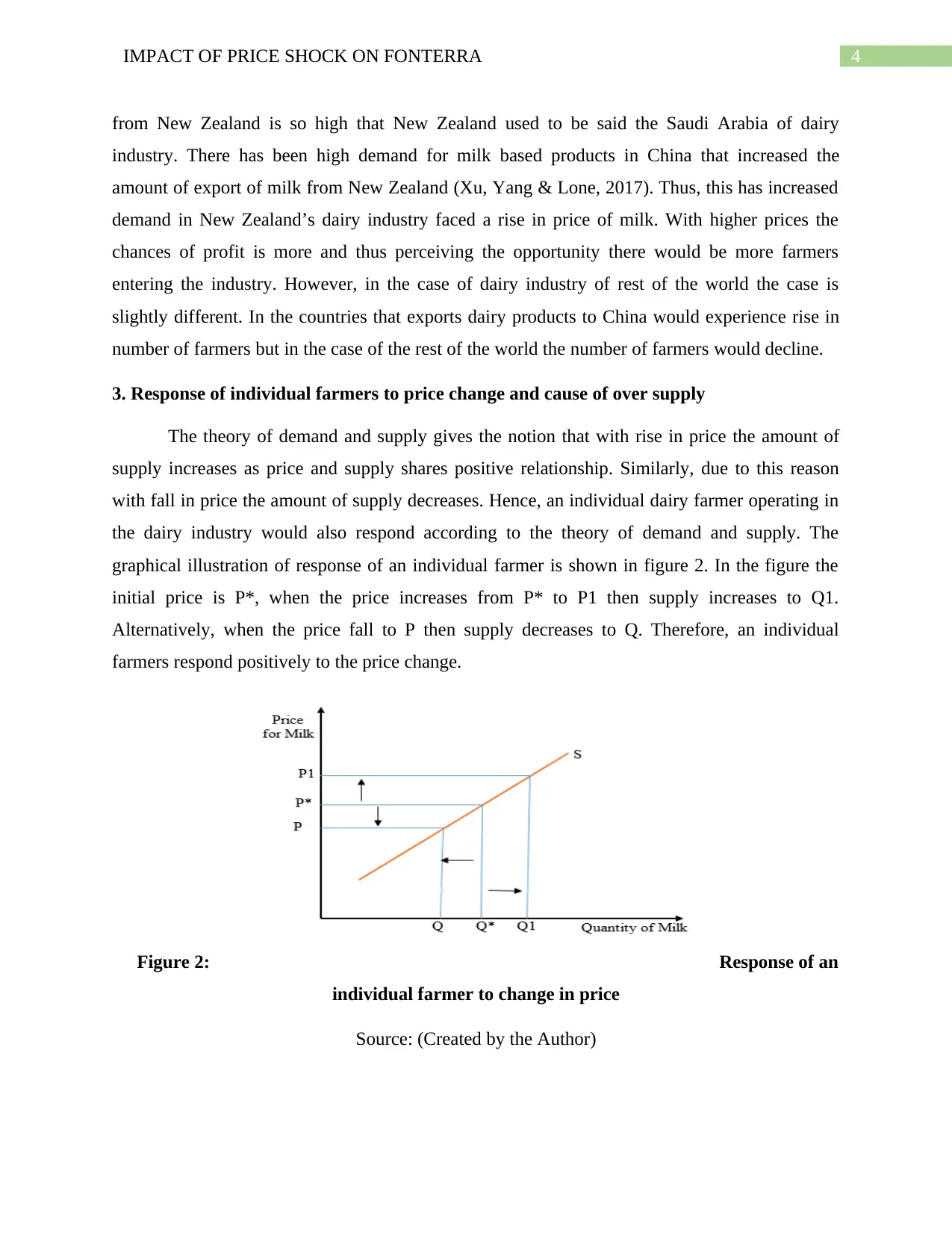
4IMPACT OF PRICE SHOCK ON FONTERRA
from New Zealand is so high that New Zealand used to be said the Saudi Arabia of dairy
industry. There has been high demand for milk based products in China that increased the
amount of export of milk from New Zealand (Xu, Yang & Lone, 2017). Thus, this has increased
demand in New Zealand’s dairy industry faced a rise in price of milk. With higher prices the
chances of profit is more and thus perceiving the opportunity there would be more farmers
entering the industry. However, in the case of dairy industry of rest of the world the case is
slightly different. In the countries that exports dairy products to China would experience rise in
number of farmers but in the case of the rest of the world the number of farmers would decline.
3. Response of individual farmers to price change and cause of over supply
The theory of demand and supply gives the notion that with rise in price the amount of
supply increases as price and supply shares positive relationship. Similarly, due to this reason
with fall in price the amount of supply decreases. Hence, an individual dairy farmer operating in
the dairy industry would also respond according to the theory of demand and supply. The
graphical illustration of response of an individual farmer is shown in figure 2. In the figure the
initial price is P*, when the price increases from P* to P1 then supply increases to Q1.
Alternatively, when the price fall to P then supply decreases to Q. Therefore, an individual
farmers respond positively to the price change.
Figure 2: Response of an
individual farmer to change in price
Source: (Created by the Author)
from New Zealand is so high that New Zealand used to be said the Saudi Arabia of dairy
industry. There has been high demand for milk based products in China that increased the
amount of export of milk from New Zealand (Xu, Yang & Lone, 2017). Thus, this has increased
demand in New Zealand’s dairy industry faced a rise in price of milk. With higher prices the
chances of profit is more and thus perceiving the opportunity there would be more farmers
entering the industry. However, in the case of dairy industry of rest of the world the case is
slightly different. In the countries that exports dairy products to China would experience rise in
number of farmers but in the case of the rest of the world the number of farmers would decline.
3. Response of individual farmers to price change and cause of over supply
The theory of demand and supply gives the notion that with rise in price the amount of
supply increases as price and supply shares positive relationship. Similarly, due to this reason
with fall in price the amount of supply decreases. Hence, an individual dairy farmer operating in
the dairy industry would also respond according to the theory of demand and supply. The
graphical illustration of response of an individual farmer is shown in figure 2. In the figure the
initial price is P*, when the price increases from P* to P1 then supply increases to Q1.
Alternatively, when the price fall to P then supply decreases to Q. Therefore, an individual
farmers respond positively to the price change.
Figure 2: Response of an
individual farmer to change in price
Source: (Created by the Author)
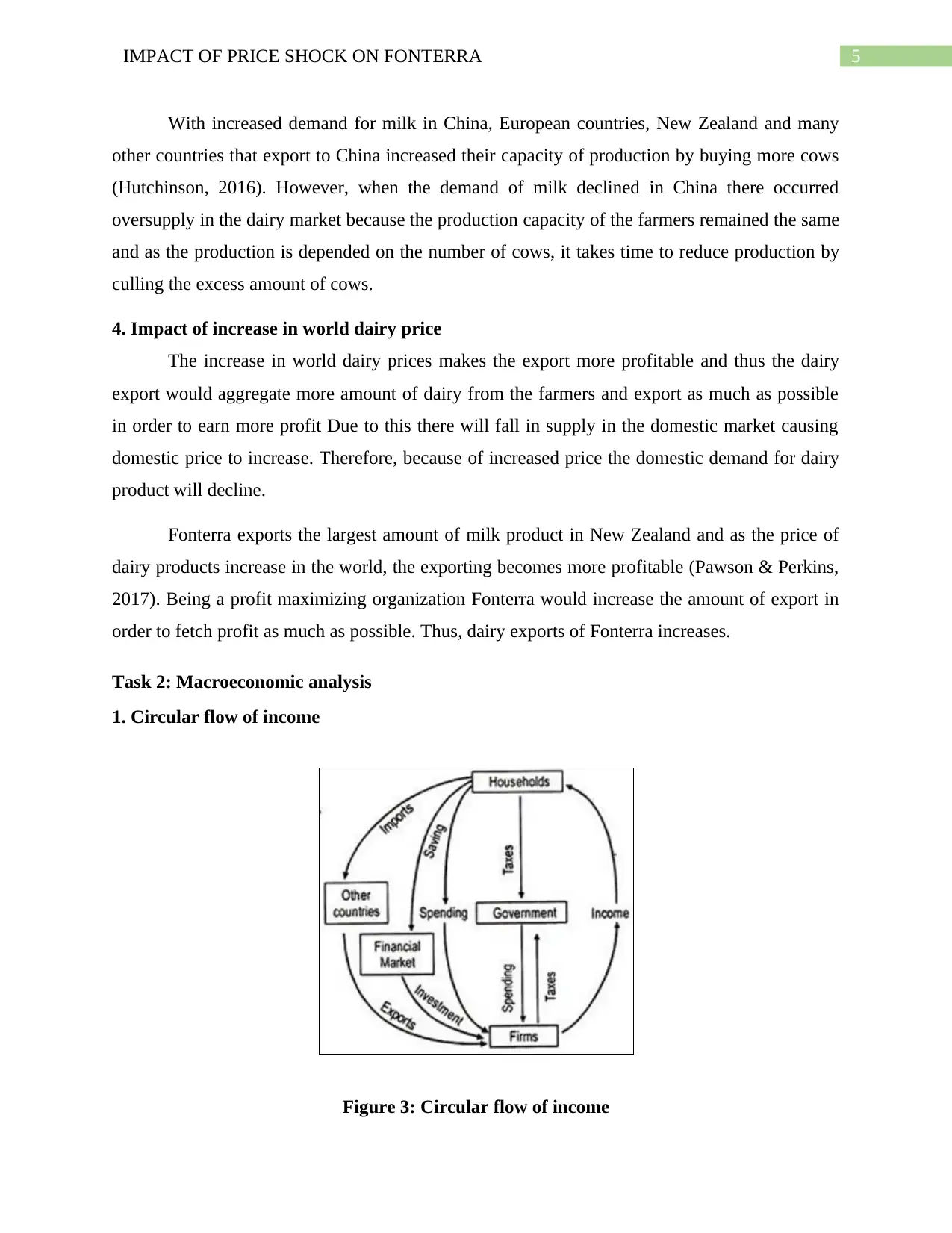
5IMPACT OF PRICE SHOCK ON FONTERRA
With increased demand for milk in China, European countries, New Zealand and many
other countries that export to China increased their capacity of production by buying more cows
(Hutchinson, 2016). However, when the demand of milk declined in China there occurred
oversupply in the dairy market because the production capacity of the farmers remained the same
and as the production is depended on the number of cows, it takes time to reduce production by
culling the excess amount of cows.
4. Impact of increase in world dairy price
The increase in world dairy prices makes the export more profitable and thus the dairy
export would aggregate more amount of dairy from the farmers and export as much as possible
in order to earn more profit Due to this there will fall in supply in the domestic market causing
domestic price to increase. Therefore, because of increased price the domestic demand for dairy
product will decline.
Fonterra exports the largest amount of milk product in New Zealand and as the price of
dairy products increase in the world, the exporting becomes more profitable (Pawson & Perkins,
2017). Being a profit maximizing organization Fonterra would increase the amount of export in
order to fetch profit as much as possible. Thus, dairy exports of Fonterra increases.
Task 2: Macroeconomic analysis
1. Circular flow of income
Figure 3: Circular flow of income
With increased demand for milk in China, European countries, New Zealand and many
other countries that export to China increased their capacity of production by buying more cows
(Hutchinson, 2016). However, when the demand of milk declined in China there occurred
oversupply in the dairy market because the production capacity of the farmers remained the same
and as the production is depended on the number of cows, it takes time to reduce production by
culling the excess amount of cows.
4. Impact of increase in world dairy price
The increase in world dairy prices makes the export more profitable and thus the dairy
export would aggregate more amount of dairy from the farmers and export as much as possible
in order to earn more profit Due to this there will fall in supply in the domestic market causing
domestic price to increase. Therefore, because of increased price the domestic demand for dairy
product will decline.
Fonterra exports the largest amount of milk product in New Zealand and as the price of
dairy products increase in the world, the exporting becomes more profitable (Pawson & Perkins,
2017). Being a profit maximizing organization Fonterra would increase the amount of export in
order to fetch profit as much as possible. Thus, dairy exports of Fonterra increases.
Task 2: Macroeconomic analysis
1. Circular flow of income
Figure 3: Circular flow of income
⊘ This is a preview!⊘
Do you want full access?
Subscribe today to unlock all pages.

Trusted by 1+ million students worldwide
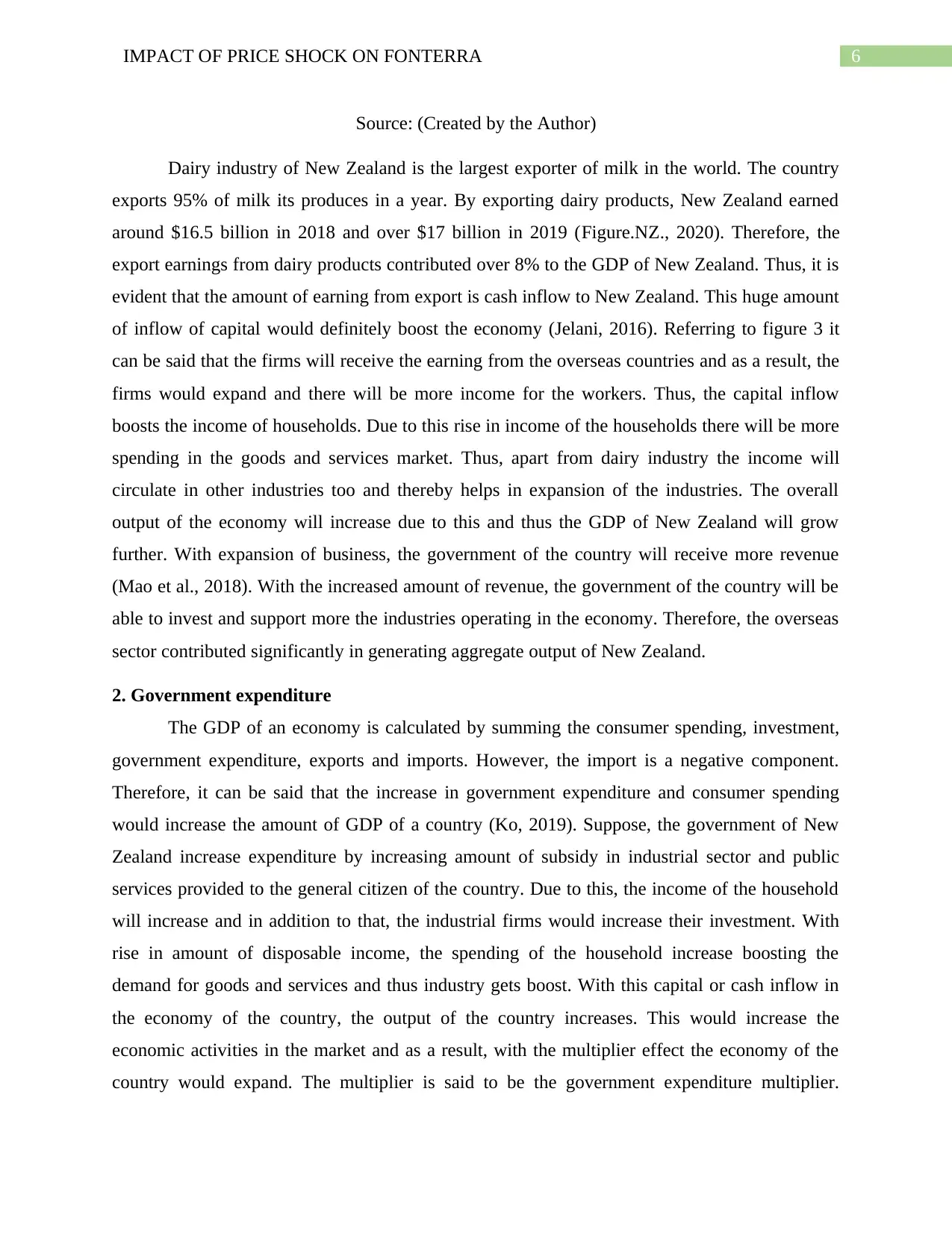
6IMPACT OF PRICE SHOCK ON FONTERRA
Source: (Created by the Author)
Dairy industry of New Zealand is the largest exporter of milk in the world. The country
exports 95% of milk its produces in a year. By exporting dairy products, New Zealand earned
around $16.5 billion in 2018 and over $17 billion in 2019 (Figure.NZ., 2020). Therefore, the
export earnings from dairy products contributed over 8% to the GDP of New Zealand. Thus, it is
evident that the amount of earning from export is cash inflow to New Zealand. This huge amount
of inflow of capital would definitely boost the economy (Jelani, 2016). Referring to figure 3 it
can be said that the firms will receive the earning from the overseas countries and as a result, the
firms would expand and there will be more income for the workers. Thus, the capital inflow
boosts the income of households. Due to this rise in income of the households there will be more
spending in the goods and services market. Thus, apart from dairy industry the income will
circulate in other industries too and thereby helps in expansion of the industries. The overall
output of the economy will increase due to this and thus the GDP of New Zealand will grow
further. With expansion of business, the government of the country will receive more revenue
(Mao et al., 2018). With the increased amount of revenue, the government of the country will be
able to invest and support more the industries operating in the economy. Therefore, the overseas
sector contributed significantly in generating aggregate output of New Zealand.
2. Government expenditure
The GDP of an economy is calculated by summing the consumer spending, investment,
government expenditure, exports and imports. However, the import is a negative component.
Therefore, it can be said that the increase in government expenditure and consumer spending
would increase the amount of GDP of a country (Ko, 2019). Suppose, the government of New
Zealand increase expenditure by increasing amount of subsidy in industrial sector and public
services provided to the general citizen of the country. Due to this, the income of the household
will increase and in addition to that, the industrial firms would increase their investment. With
rise in amount of disposable income, the spending of the household increase boosting the
demand for goods and services and thus industry gets boost. With this capital or cash inflow in
the economy of the country, the output of the country increases. This would increase the
economic activities in the market and as a result, with the multiplier effect the economy of the
country would expand. The multiplier is said to be the government expenditure multiplier.
Source: (Created by the Author)
Dairy industry of New Zealand is the largest exporter of milk in the world. The country
exports 95% of milk its produces in a year. By exporting dairy products, New Zealand earned
around $16.5 billion in 2018 and over $17 billion in 2019 (Figure.NZ., 2020). Therefore, the
export earnings from dairy products contributed over 8% to the GDP of New Zealand. Thus, it is
evident that the amount of earning from export is cash inflow to New Zealand. This huge amount
of inflow of capital would definitely boost the economy (Jelani, 2016). Referring to figure 3 it
can be said that the firms will receive the earning from the overseas countries and as a result, the
firms would expand and there will be more income for the workers. Thus, the capital inflow
boosts the income of households. Due to this rise in income of the households there will be more
spending in the goods and services market. Thus, apart from dairy industry the income will
circulate in other industries too and thereby helps in expansion of the industries. The overall
output of the economy will increase due to this and thus the GDP of New Zealand will grow
further. With expansion of business, the government of the country will receive more revenue
(Mao et al., 2018). With the increased amount of revenue, the government of the country will be
able to invest and support more the industries operating in the economy. Therefore, the overseas
sector contributed significantly in generating aggregate output of New Zealand.
2. Government expenditure
The GDP of an economy is calculated by summing the consumer spending, investment,
government expenditure, exports and imports. However, the import is a negative component.
Therefore, it can be said that the increase in government expenditure and consumer spending
would increase the amount of GDP of a country (Ko, 2019). Suppose, the government of New
Zealand increase expenditure by increasing amount of subsidy in industrial sector and public
services provided to the general citizen of the country. Due to this, the income of the household
will increase and in addition to that, the industrial firms would increase their investment. With
rise in amount of disposable income, the spending of the household increase boosting the
demand for goods and services and thus industry gets boost. With this capital or cash inflow in
the economy of the country, the output of the country increases. This would increase the
economic activities in the market and as a result, with the multiplier effect the economy of the
country would expand. The multiplier is said to be the government expenditure multiplier.
Paraphrase This Document
Need a fresh take? Get an instant paraphrase of this document with our AI Paraphraser
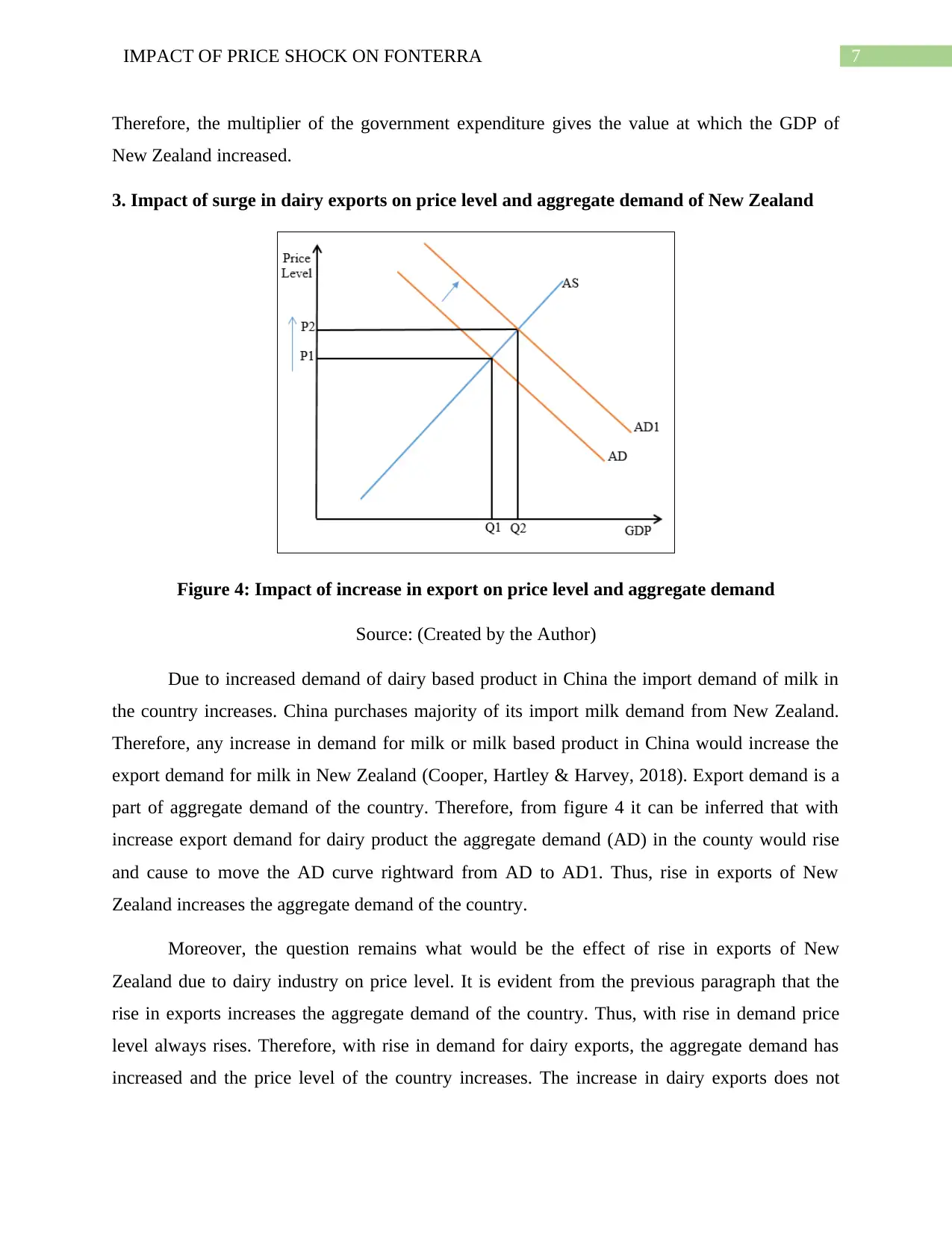
7IMPACT OF PRICE SHOCK ON FONTERRA
Therefore, the multiplier of the government expenditure gives the value at which the GDP of
New Zealand increased.
3. Impact of surge in dairy exports on price level and aggregate demand of New Zealand
Figure 4: Impact of increase in export on price level and aggregate demand
Source: (Created by the Author)
Due to increased demand of dairy based product in China the import demand of milk in
the country increases. China purchases majority of its import milk demand from New Zealand.
Therefore, any increase in demand for milk or milk based product in China would increase the
export demand for milk in New Zealand (Cooper, Hartley & Harvey, 2018). Export demand is a
part of aggregate demand of the country. Therefore, from figure 4 it can be inferred that with
increase export demand for dairy product the aggregate demand (AD) in the county would rise
and cause to move the AD curve rightward from AD to AD1. Thus, rise in exports of New
Zealand increases the aggregate demand of the country.
Moreover, the question remains what would be the effect of rise in exports of New
Zealand due to dairy industry on price level. It is evident from the previous paragraph that the
rise in exports increases the aggregate demand of the country. Thus, with rise in demand price
level always rises. Therefore, with rise in demand for dairy exports, the aggregate demand has
increased and the price level of the country increases. The increase in dairy exports does not
Therefore, the multiplier of the government expenditure gives the value at which the GDP of
New Zealand increased.
3. Impact of surge in dairy exports on price level and aggregate demand of New Zealand
Figure 4: Impact of increase in export on price level and aggregate demand
Source: (Created by the Author)
Due to increased demand of dairy based product in China the import demand of milk in
the country increases. China purchases majority of its import milk demand from New Zealand.
Therefore, any increase in demand for milk or milk based product in China would increase the
export demand for milk in New Zealand (Cooper, Hartley & Harvey, 2018). Export demand is a
part of aggregate demand of the country. Therefore, from figure 4 it can be inferred that with
increase export demand for dairy product the aggregate demand (AD) in the county would rise
and cause to move the AD curve rightward from AD to AD1. Thus, rise in exports of New
Zealand increases the aggregate demand of the country.
Moreover, the question remains what would be the effect of rise in exports of New
Zealand due to dairy industry on price level. It is evident from the previous paragraph that the
rise in exports increases the aggregate demand of the country. Thus, with rise in demand price
level always rises. Therefore, with rise in demand for dairy exports, the aggregate demand has
increased and the price level of the country increases. The increase in dairy exports does not
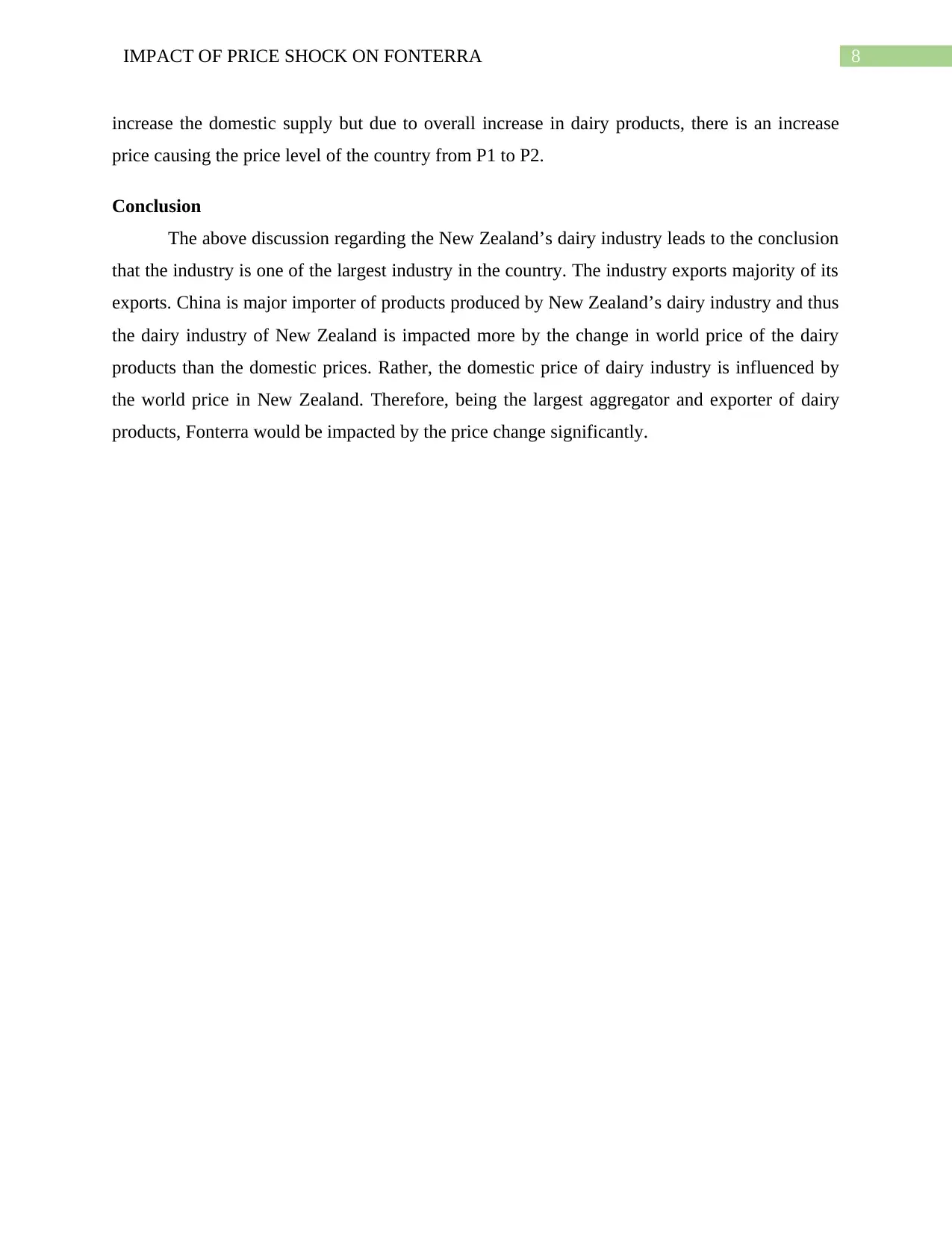
8IMPACT OF PRICE SHOCK ON FONTERRA
increase the domestic supply but due to overall increase in dairy products, there is an increase
price causing the price level of the country from P1 to P2.
Conclusion
The above discussion regarding the New Zealand’s dairy industry leads to the conclusion
that the industry is one of the largest industry in the country. The industry exports majority of its
exports. China is major importer of products produced by New Zealand’s dairy industry and thus
the dairy industry of New Zealand is impacted more by the change in world price of the dairy
products than the domestic prices. Rather, the domestic price of dairy industry is influenced by
the world price in New Zealand. Therefore, being the largest aggregator and exporter of dairy
products, Fonterra would be impacted by the price change significantly.
increase the domestic supply but due to overall increase in dairy products, there is an increase
price causing the price level of the country from P1 to P2.
Conclusion
The above discussion regarding the New Zealand’s dairy industry leads to the conclusion
that the industry is one of the largest industry in the country. The industry exports majority of its
exports. China is major importer of products produced by New Zealand’s dairy industry and thus
the dairy industry of New Zealand is impacted more by the change in world price of the dairy
products than the domestic prices. Rather, the domestic price of dairy industry is influenced by
the world price in New Zealand. Therefore, being the largest aggregator and exporter of dairy
products, Fonterra would be impacted by the price change significantly.
⊘ This is a preview!⊘
Do you want full access?
Subscribe today to unlock all pages.

Trusted by 1+ million students worldwide
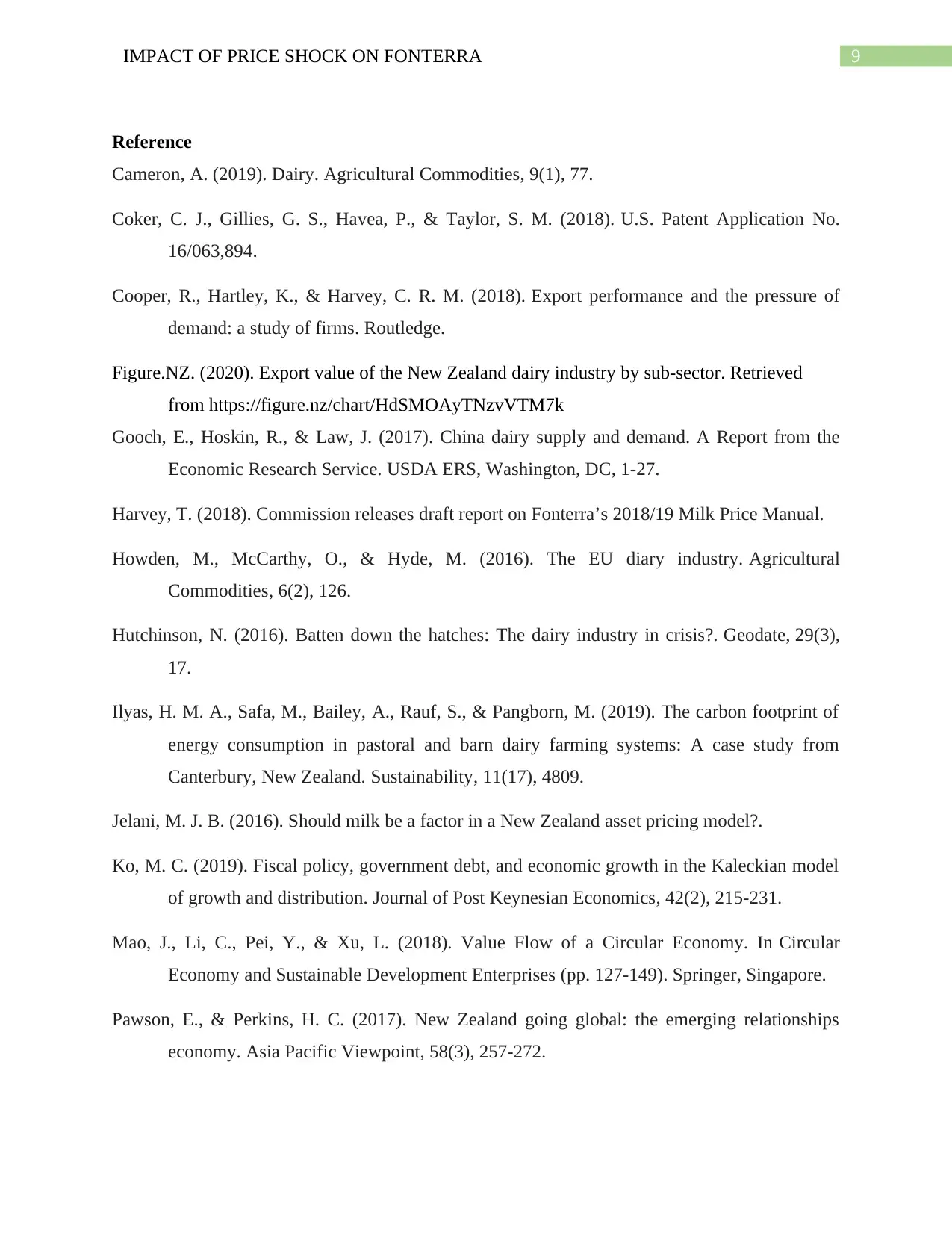
9IMPACT OF PRICE SHOCK ON FONTERRA
Reference
Cameron, A. (2019). Dairy. Agricultural Commodities, 9(1), 77.
Coker, C. J., Gillies, G. S., Havea, P., & Taylor, S. M. (2018). U.S. Patent Application No.
16/063,894.
Cooper, R., Hartley, K., & Harvey, C. R. M. (2018). Export performance and the pressure of
demand: a study of firms. Routledge.
Figure.NZ. (2020). Export value of the New Zealand dairy industry by sub-sector. Retrieved
from https://figure.nz/chart/HdSMOAyTNzvVTM7k
Gooch, E., Hoskin, R., & Law, J. (2017). China dairy supply and demand. A Report from the
Economic Research Service. USDA ERS, Washington, DC, 1-27.
Harvey, T. (2018). Commission releases draft report on Fonterra’s 2018/19 Milk Price Manual.
Howden, M., McCarthy, O., & Hyde, M. (2016). The EU diary industry. Agricultural
Commodities, 6(2), 126.
Hutchinson, N. (2016). Batten down the hatches: The dairy industry in crisis?. Geodate, 29(3),
17.
Ilyas, H. M. A., Safa, M., Bailey, A., Rauf, S., & Pangborn, M. (2019). The carbon footprint of
energy consumption in pastoral and barn dairy farming systems: A case study from
Canterbury, New Zealand. Sustainability, 11(17), 4809.
Jelani, M. J. B. (2016). Should milk be a factor in a New Zealand asset pricing model?.
Ko, M. C. (2019). Fiscal policy, government debt, and economic growth in the Kaleckian model
of growth and distribution. Journal of Post Keynesian Economics, 42(2), 215-231.
Mao, J., Li, C., Pei, Y., & Xu, L. (2018). Value Flow of a Circular Economy. In Circular
Economy and Sustainable Development Enterprises (pp. 127-149). Springer, Singapore.
Pawson, E., & Perkins, H. C. (2017). New Zealand going global: the emerging relationships
economy. Asia Pacific Viewpoint, 58(3), 257-272.
Reference
Cameron, A. (2019). Dairy. Agricultural Commodities, 9(1), 77.
Coker, C. J., Gillies, G. S., Havea, P., & Taylor, S. M. (2018). U.S. Patent Application No.
16/063,894.
Cooper, R., Hartley, K., & Harvey, C. R. M. (2018). Export performance and the pressure of
demand: a study of firms. Routledge.
Figure.NZ. (2020). Export value of the New Zealand dairy industry by sub-sector. Retrieved
from https://figure.nz/chart/HdSMOAyTNzvVTM7k
Gooch, E., Hoskin, R., & Law, J. (2017). China dairy supply and demand. A Report from the
Economic Research Service. USDA ERS, Washington, DC, 1-27.
Harvey, T. (2018). Commission releases draft report on Fonterra’s 2018/19 Milk Price Manual.
Howden, M., McCarthy, O., & Hyde, M. (2016). The EU diary industry. Agricultural
Commodities, 6(2), 126.
Hutchinson, N. (2016). Batten down the hatches: The dairy industry in crisis?. Geodate, 29(3),
17.
Ilyas, H. M. A., Safa, M., Bailey, A., Rauf, S., & Pangborn, M. (2019). The carbon footprint of
energy consumption in pastoral and barn dairy farming systems: A case study from
Canterbury, New Zealand. Sustainability, 11(17), 4809.
Jelani, M. J. B. (2016). Should milk be a factor in a New Zealand asset pricing model?.
Ko, M. C. (2019). Fiscal policy, government debt, and economic growth in the Kaleckian model
of growth and distribution. Journal of Post Keynesian Economics, 42(2), 215-231.
Mao, J., Li, C., Pei, Y., & Xu, L. (2018). Value Flow of a Circular Economy. In Circular
Economy and Sustainable Development Enterprises (pp. 127-149). Springer, Singapore.
Pawson, E., & Perkins, H. C. (2017). New Zealand going global: the emerging relationships
economy. Asia Pacific Viewpoint, 58(3), 257-272.
Paraphrase This Document
Need a fresh take? Get an instant paraphrase of this document with our AI Paraphraser
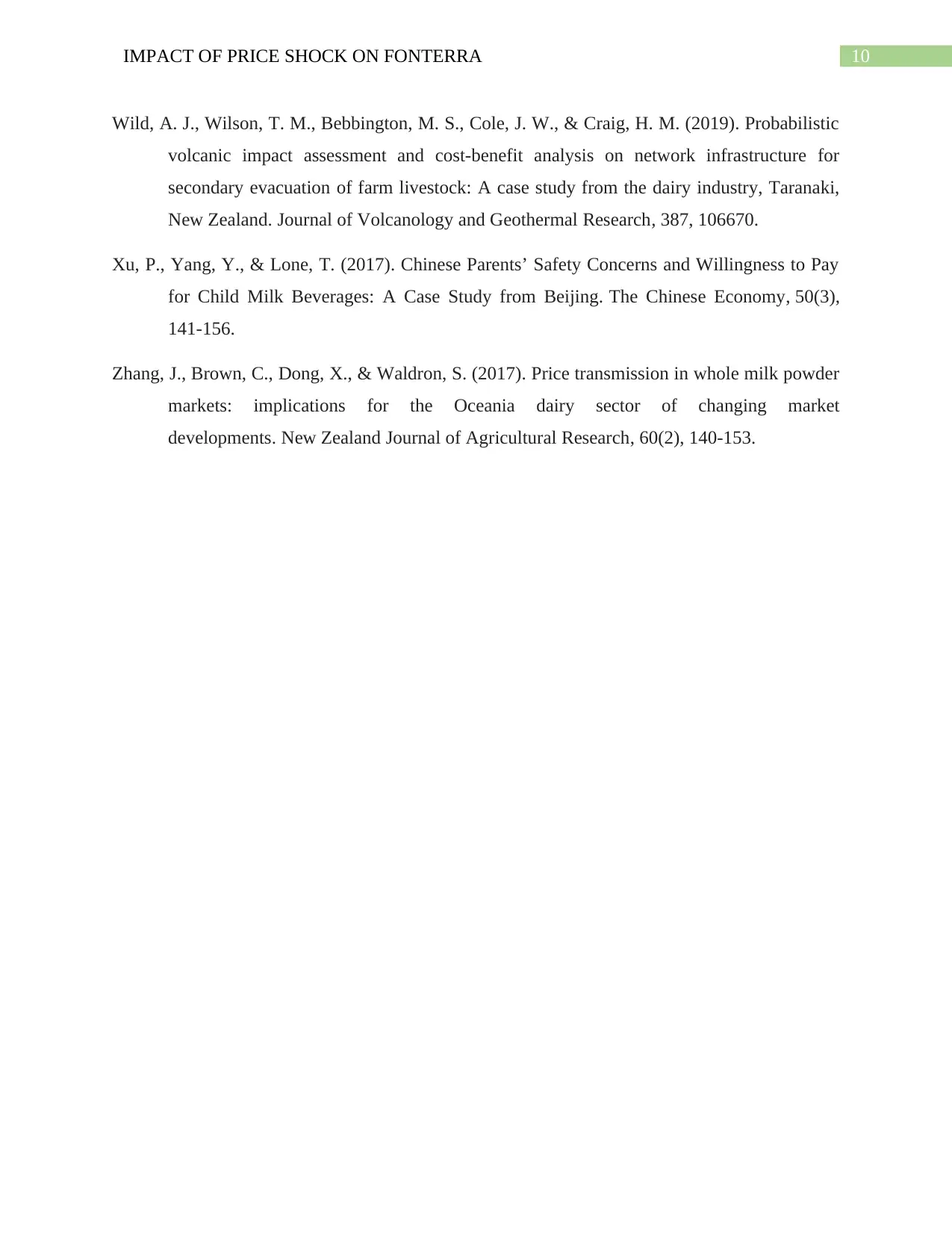
10IMPACT OF PRICE SHOCK ON FONTERRA
Wild, A. J., Wilson, T. M., Bebbington, M. S., Cole, J. W., & Craig, H. M. (2019). Probabilistic
volcanic impact assessment and cost-benefit analysis on network infrastructure for
secondary evacuation of farm livestock: A case study from the dairy industry, Taranaki,
New Zealand. Journal of Volcanology and Geothermal Research, 387, 106670.
Xu, P., Yang, Y., & Lone, T. (2017). Chinese Parents’ Safety Concerns and Willingness to Pay
for Child Milk Beverages: A Case Study from Beijing. The Chinese Economy, 50(3),
141-156.
Zhang, J., Brown, C., Dong, X., & Waldron, S. (2017). Price transmission in whole milk powder
markets: implications for the Oceania dairy sector of changing market
developments. New Zealand Journal of Agricultural Research, 60(2), 140-153.
Wild, A. J., Wilson, T. M., Bebbington, M. S., Cole, J. W., & Craig, H. M. (2019). Probabilistic
volcanic impact assessment and cost-benefit analysis on network infrastructure for
secondary evacuation of farm livestock: A case study from the dairy industry, Taranaki,
New Zealand. Journal of Volcanology and Geothermal Research, 387, 106670.
Xu, P., Yang, Y., & Lone, T. (2017). Chinese Parents’ Safety Concerns and Willingness to Pay
for Child Milk Beverages: A Case Study from Beijing. The Chinese Economy, 50(3),
141-156.
Zhang, J., Brown, C., Dong, X., & Waldron, S. (2017). Price transmission in whole milk powder
markets: implications for the Oceania dairy sector of changing market
developments. New Zealand Journal of Agricultural Research, 60(2), 140-153.
1 out of 11
Related Documents
Your All-in-One AI-Powered Toolkit for Academic Success.
+13062052269
info@desklib.com
Available 24*7 on WhatsApp / Email
![[object Object]](/_next/static/media/star-bottom.7253800d.svg)
Unlock your academic potential
Copyright © 2020–2025 A2Z Services. All Rights Reserved. Developed and managed by ZUCOL.





